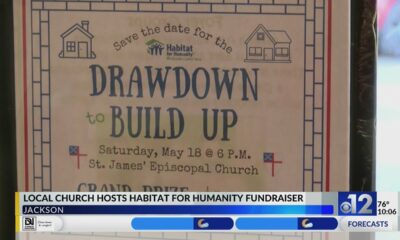Kaiser Health News
‘I Am Just Waiting to Die’: Social Security Clawbacks Drive Some Into Homelessness
Fred Clasen-Kelly
Wed, 20 Dec 2023 10:00:00 +0000
More than a year after the federal government first cut off her disability benefits, Denise Woods drives nightly to strip malls, truck stops, and parking lots around Savannah, Georgia, looking for a safe place to sleep in her Chevy.
Woods, 51, said she had rented a three-bedroom house she shared with her adult son and grandson until March 2022, when the government terminated her disability payments without notice.
According to letters sent by the Social Security Administration, the agency determined it had been overpaying Woods and demanded she send back nearly $58,000.
Woods couldn't come up with the money. So, until February 2026, the agency is withholding the $2,048 in disability she would have received each month.
“I still don't know how it happened,” said Woods, who has requested a waiver and is seeking a hearing. “No one will give me answers. It takes weeks or months to get a caseworker on the phone. They have made my life unbearable.”
Kilolo Kijakazi, acting commissioner of the Social Security Administration, told a congressional subcommittee in October that her agency notifies recipients when they have received overpayments and works to “help those who want to establish repayment plans or who seek waiver of the debt.”
But relief from overpayments goes to only a relatively small number of people. And many others face dire consequences: Some become homeless, are evicted from rental housing, or see their mortgages fall into foreclosure.
The SSA has a painful legacy of excluding Black people from benefits. Today the agency's own published research shows its overpayments most often hit Black and Hispanic people, the poorest of the poor, those with the least education, and those whose medical conditions are unlikely to improve.
Woods is one of millions who have been targeted in the Social Security Administration's attempt to claw back billions of dollars it says was wrongly sent to beneficiaries. Years can pass before the agency catches a mistake, and even the little bit extra it might send each month can add up.
In reclaiming it, the government is imposing debts that can reach tens of thousands of dollars against those least able to pay.
‘Wreaking Havoc in People's Lives'
KFF Health News and Cox Media Group reporters interviewed people who have received overpayment notices and nonprofit attorneys who advocate for them and reviewed SSA publications, policy papers, and congressional testimony.
A 64-year-old Florida man said he could no longer afford rent after his Social Security retirement payments were garnished last year because he allegedly had been overpaid $35,176 in disability benefits. He said he now lives in a tent in the woods. A 24-year-old Pennsylvania woman living with her mother and younger siblings in public housing lost the chance to buy her own home because of an alleged $6,063 overpayment that accrued when she was a child.
“Social Security overpayments are wreaking havoc in people's lives,” said Jen Burdick, an attorney with Community Legal Services of Philadelphia, which represents clients who have received overpayment notices. “They are asking the poorest among us to account for every dollar they get. Under their rules, some people can save up money for a funeral burial but not enough to get housing.”
Woods has lupus and congestive heart failure and struggles to walk, but she started working part-time after her benefits were rescinded. She said she makes $14 an hour transporting railroad crew members in her 2015 Chevy Equinox between Savannah and Jacksonville, Florida, when she can get assignments and her health allows it.
The SUV costs $386 a month — a large portion of her income — but without it, Woods said, she would not have a job or a place to sleep.
“My life is just survival now,” Woods said. “Sometimes I feel like I am just waiting to die.”
The Social Security Administration has said it is required by law to attempt to recover overpayments. Notices ask beneficiaries to repay the money directly. Authorities can also recoup money by reducing or halting monthly benefits and garnishing wages and federal tax refunds.
Agency officials describe an orderly process in which they explain to beneficiaries the reason for the overpayment and offer the chance to appeal the decision and have the charges waived if they cannot afford it. One way to qualify for a waiver is if “paying us back would mean you could not pay your bills for food, clothing, housing, medical care or other necessary expenses,” according to a letter sent to one recipient.
Those most impacted by Social Security's decisions, including people with disabilities and widows receiving survivors' benefits, paint a different picture. They talk about having their benefits terminated without explanation or warning, an appeals process that can drag on for years, and an inability to get answers from the SSA to even basic questions.
Nancy Altman, president of Social Security Works, a group that pushes for the protection and expansion of the program, recalled how stressful it was when a colleague's mother received an overpayment notice.
“After weeks of nonstop phone calls, he was able to get the matter resolved, but not before it put his mother in the hospital,” Altman said. “One can just imagine how much worse it would be for someone for whom English is not their native language, who lacks a high school education, and who is unassisted by such a knowledgeable and caring advocate.”
Problems surrounding the Social Security Administration are aggravated by congressional actions, including funding shortages that brought agency staffing to a 25-year low by the end of fiscal year 2022. Even so, advocates for people with disabilities say the agency does far less than it could to help people who have been overpaid, often through no fault of their own.
They said challenges faced by beneficiaries underscore how overpayments disproportionately impact Black people and other minority groups even as President Joe Biden and Social Security leaders promise to fix racial inequity in government programs.
Most overpayments are linked to the Supplemental Security Income program, which gives money to people with little or no income who are disabled, blind, or at least 65. The majority of SSI recipients are Black, Hispanic, or Asian people.
“Congress has turned a blind eye to this,” said David Weaver, a former associate commissioner for research, demonstration, and employment support at the SSA. Politicians “just want to save money. It is misplaced priorities. It is completely inexcusable.”
The Social Security Administration did not make its leaders available for an interview. Spokesperson Nicole Tiggemann declined to answer questions about the cases of Woods and other beneficiaries, citing privacy laws.
In a written statement, Tiggemann acknowledged that receiving an overpayment notice can be “unsettling,” but said the agency helps beneficiaries navigate the process and informs them of their rights if they believe they were not at fault or cannot repay the debt.
“Even if they do not want to appeal or request a waiver, the notice says to contact us if the planned withholding would cause hardship,” Tiggemann said. “We have flexible repayment options — including repayment of as low as $10 per month. Each person's situation is unique, and we handle overpayments on a case-by-case basis.”
Critics say fighting an overpayment notice is not that simple.
Beneficiaries — many challenged by physical, mental, or intellectual disabilities — often are overwhelmed by complex paperwork or unable to find financial documents that may be years old.
The Social Security Administration has the authority to waive overpayments if officials determine recovering them would violate “equity and good conscience,” or the disputed amount falls below certain thresholds. The agency's guidance also says collecting an overpayment “defeats the purpose” when the “individual needs substantially all of their current income to meet their current ordinary and necessary living expenses.”
Advocates for people with disabilities contend most overpayments arise from delays in processing paperwork and errors by the Social Security Administration or recipients making innocent mistakes. The agency can waive overpayments when the beneficiary is found not at fault.
But in fiscal year 2023, the Social Security Administration collected about $4.9 billion in overpayments with an additional $23 billion yet uncollected, according to an agency report. Just $267 million was waived, the report said.
David Camp, the interim chief executive officer of the National Organization of Social Security Claimants' Representatives, which advocates for improvements in federal disability programs, said the Social Security Administration is a “broken structure.”
The agency sometimes tries to claw back overpayments from people falsely accused of failing to provide required documents, Camp said.
“Dropping off forms at their field offices is not a guarantee” paperwork will be processed, he said. “Mail is slow, or it doesn't get opened. We see it so many times you are left with the idea that has to do with the structure.”
Left Destitute
Advocacy groups and others said they don't know how many people become homeless after their benefits are terminated, but they say anecdotal accounts are common.
A study found that more than 800,000 disability applicants from 2007 to 2017 experienced homelessness. Advocates say it only makes sense that overpayments could lead more people to become homeless, since nearly 40% of people receiving disability benefits experience food insecurity and cannot keep up with their rent and utility bills, according to research.
Ronald Harrell sleeps in the woods near Wildwood, Florida, about 50 miles northwest of Orlando. He said he shelters in a tent, cooks his meals on a small grill, and showers at a friend's house.
Harrell, 64, said he rented a room in a house for $125 a week until last year, when the Social Security Administration cut off his retirement benefits.
A letter the SSA sent him, dated Feb. 6, 2023, says his benefits are being withheld because of overpayment of $35,176 that accrued when Harrell received disability payments. The letter acknowledges he has asked the agency to lower his payments.
“I don't know how they are doing this to me,” Harrell said. “I did everything by the law.”
Harrell said he once worked as an HVAC technician, but nerve damage left him unable to work sometime around 2002.
He said he collected disability benefits until about 2009, when rehabilitation allowed him to return to the workforce, and he said he reported the information to the federal government. Harrell said he applied for early Social Security retirement benefits last year when his health again declined.
“I started working when I was 16,” Harrell said. “I never thought my life would be like this.”
Kijakazi, the acting Social Security commissioner, and others have said overpayments stem at least partly from low staffing and budget cuts.
From 2010 to 2023, the agency's customer service budget dropped by 17%, after inflation, according to a report by the Center on Budget and Policy Priorities, a think tank that conducts research on government programs.
At the same time, the report says, the number of Social Security beneficiaries grew by nearly 12 million people, or 22%.
Jonathan Stein, a former attorney with Community Legal Services of Philadelphia who has participated in workgroups and meetings with federal officials about access to Social Security payments for vulnerable populations, said budget cuts cannot fully account for the agency's penchant for denying applications and terminating benefits.
Officials suspended Supplemental Security Income benefits for about 136,540 people in 2019 for “failure to furnish report,” which means they did not meet deadlines or paperwork requirements, Stein said, despite knowing many of those people were unable to contact the agency because they are homeless or have been evicted and lost access to phones and computers.
That's more than double the number in 2010, he said.
“They have an implicit bias for denying benefits,” Stein said. “It is a very skewed view of integrity. It reinforces a culture of suspicion and prosecution of applicants.”
The 24-year-old Pennsylvania woman who received Supplemental Security Income as a child because of a learning disability described her ordeal on the condition that her name not be published. A letter from the Social Security Administration says she received an overpayment notice for more than $6,000.
“It was frustrating,” the woman said. “You are dealing with nasty people on the phone. I couldn't get any answers.”
In November 2022, she contacted a nonprofit law firm, which helped her file an appeal. One year later, she received another letter from Social Security saying the overpayment had been waived because it was not her fault. The letter also said officials would not seek repayment because she could not afford basic needs such as food and housing without the monthly benefits.
The woman had already paid a price.
She lived in public housing and the Philadelphia Housing Authority had offered her a chance to fulfill a long-held goal of owning a house. But when the overpayment appeared on her credit report, she said, she could not obtain a mortgage.
“I was excited about getting my own home,” she said. “That's what everybody wants. Losing it is not a good feeling.”
David Hilzenrath of KFF Health News, Jodie Fleischer of Cox Media Group, and Ben Becker of ActionNewsJax in Jacksonville, Florida, contributed to this report.
Do you have an experience with Social Security overpayments you'd like to share? Click here to contact our reporting team.
——————————
By: Fred Clasen-Kelly
Title: ‘I Am Just Waiting to Die': Social Security Clawbacks Drive Some Into Homelessness
Sourced From: kffhealthnews.org/news/article/social-security-clawbacks-homelessness/
Published Date: Wed, 20 Dec 2023 10:00:00 +0000
Did you miss our previous article…
https://www.biloxinewsevents.com/when-a-quick-telehealth-visit-yields-multiple-surprises-beyond-a-big-bill/
Kaiser Health News
The Lure of Specialty Medicine Pulls Nurse Practitioners From Primary Care
Michelle Andrews
Fri, 17 May 2024 09:00:00 +0000
For many patients, seeing a nurse practitioner has become a routine part of primary care, in which these “NPs” often perform the same tasks that patients have relied on doctors for.
But NPs in specialty care? That's not routine, at least not yet. Increasingly, though, nurse practitioners and physician assistants are joining cardiology, dermatology, and other specialty practices, broadening their skills and increasing their income.
This development worries some people who track the health workforce, because current trends suggest primary care, which has counted on nurse practitioners to backstop physician shortages, soon might not be able to rely on them to the same extent.
“They're succumbing to the same challenges that we have with physicians,” said Atul Grover, executive director of the Research and Action Institute at the Association of American Medical Colleges. The rates NPs can command in a specialty practice “are quite a bit higher” than practice salaries in primary care, he said.
When nurse practitioner programs began to proliferate in the 1970s, “at first it looked great, producing all these nurse practitioners that go to work with primary care physicians,” said Yalda Jabbarpour, director of the American Academy of Family Physicians' Robert Graham Center for Policy Studies. “But now only 30% are going into primary care.”
Jabbarpour was referring to the 2024 primary care scorecard by the Milbank Memorial Fund, which found that from 2016 to 2021 the proportion of nurse practitioners who worked in primary care practices hovered between 32% and 34%, even though their numbers grew rapidly. The proportion of physician assistants, also known as physician associates, in primary care ranged from 27% to 30%, the study found.
Both nurse practitioners and physician assistants are advanced practice clinicians who, in addition to graduate degrees, must complete distinct education, training, and certification steps. NPs can practice without a doctor's supervision in more than two dozen states, while PAs have similar independence in only a handful of states.
About 88% of nurse practitioners are certified in an area of primary care, according to the American Association of Nurse Practitioners. But it is difficult to track exactly how many work in primary care or in specialty practices. Unlike physicians, they're generally not required to be endorsed by a national standard-setting body to practice in specialties like oncology or cardiology, for example. The AANP declined to answer questions about its annual workforce survey or the extent to which primary care NPs are moving toward specialties.
Though data tracking the change is sparse, specialty practices are adding these advanced practice clinicians at almost the same rate as primary care practices, according to frequently cited research published in 2018.
The clearest evidence of the shift: From 2008 to 2016, there was a 22% increase in the number of specialty practices that employed nurse practitioners and physician assistants, according to that study. The increase in the number of primary care practices that employed these professionals was 24%.
Once more, the most recent projections by the Association of American Medical Colleges predict a dearth of at least 20,200 primary care physicians by 2036. There will also be a shortfall of non-primary care specialists, including a deficiency of at least 10,100 surgical physicians and up to 25,000 physicians in other specialties.
When it comes to the actual work performed, the lines between primary and specialty care are often blurred, said Candice Chen, associate professor of health policy and management at George Washington University.
“You might be a nurse practitioner working in a gastroenterology clinic or cardiology clinic, but the scope of what you do is starting to overlap with primary care,” she said.
Nurse practitioners' salaries vary widely by location, type of facility, and experience. Still, according to data from health care recruiter AMN Healthcare Physician Solutions, formerly known as Merritt Hawkins, the total annual average starting compensation, including signing bonus, for nurse practitioners and physician assistants in specialty practice was $172,544 in the year that ended March 31, slightly higher than the $166,544 for those in primary care.
According to forecasts from the federal Bureau of Labor Statistics, nurse practitioner jobs will increase faster than jobs in almost any other occupation in the decade leading up to 2032, growing by 123,600 jobs or 45%. (Wind turbine service technician is the only other occupation projected to grow as fast.) The growth rate for physician assistants is also much faster than average, at 27%. There are more than twice as many nurse practitioners as physician assistants, however: 323,900 versus 148,000, in 2022.
To Grover, of the AAMC, numbers like this signal that there will probably be enough NPs, PAs, and physicians to meet primary care needs. At the same time, “expect more NPs and PAs to also flow out into other specialties,” he said.
When Pamela Ograbisz started working as a registered nurse 27 years ago, she worked in a cardiothoracic intensive care unit. After she became a family nurse practitioner a few years later, she found a job with a similar specialty practice, which trained her to take on a bigger role, first running their outpatient clinic, then working on the floor, and later in the intensive care unit.
If nurse practitioners want to specialize, often “the doctors mentor them just like they would with a physician residency,” said Ograbisz, now vice president of clinical operations at temporary placement recruiter LocumTenens.com.
If physician assistants want to specialize, they also can do so through mentoring, or they can receive “certificates of added qualifications” in 10 specialties to demonstrate their expertise. Most employers don't “encourage or require” these certificates, however, said Jennifer Orozco, chief medical officer at the American Academy of Physician Associates.
There are a number of training programs for family nurse practitioners who want to develop skills in other areas.
Raina Hoebelheinrich, 40, a family nurse practitioner at a regional medical center in Yankton, South Dakota, recently enrolled in a three-semester post-master's endocrinology training program at Mount Marty University. She lives on a farm in nearby northeastern Nebraska with her husband and five sons.
Hoebelheinrich's new skills could be helpful in her current hospital job, in which she sees a lot of patients with acute diabetes, or in a clinic setting like the one in Sioux Falls, South Dakota, where she is doing her clinical endocrinology training.
Lack of access to endocrinology care in rural areas is a real problem, and many people may travel hundreds of miles to see a specialist.
“There aren't a lot of options,” she said.
——————————
By: Michelle Andrews
Title: The Lure of Specialty Medicine Pulls Nurse Practitioners From Primary Care
Sourced From: kffhealthnews.org/news/article/nurse-practitioners-trend-primary-care-specialties/
Published Date: Fri, 17 May 2024 09:00:00 +0000
Did you miss our previous article…
https://www.biloxinewsevents.com/clean-needles-save-lives-in-some-states-they-might-not-be-legal/
Kaiser Health News
Clean Needles Save Lives. In Some States, They Might Not Be Legal.
Ed Mahon, Spotlight PA and Sarah Boden, WESA
Fri, 17 May 2024 09:00:00 +0000
Kim Botteicher hardly thinks of herself as a criminal.
On the main floor of a former Catholic church in Bolivar, Pennsylvania, Botteicher runs a flower shop and cafe.
In the former church's basement, she also operates a nonprofit organization focused on helping people caught up in the drug epidemic get back on their feet.
The nonprofit, FAVOR ~ Western PA, sits in a rural pocket of the Allegheny Mountains east of Pittsburgh. Her organization's home county of Westmoreland has seen roughly 100 or more drug overdose deaths each year for the past several years, the majority involving fentanyl.
Thousands more residents in the region have been touched by the scourge of addiction, which is where Botteicher comes in.
She helps people find housing, jobs, and health care, and works with families by running support groups and explaining that substance use disorder is a disease, not a moral failing.
But she has also talked publicly about how she has made sterile syringes available to people who use drugs.
“When that person comes in the door,” she said, “if they are covered with abscesses because they have been using needles that are dirty, or they've been sharing needles — maybe they've got hep C — we see that as, ‘OK, this is our first step.'”
Studies have identified public health benefits associated with syringe exchange services. The Centers for Disease Control and Prevention says these programs reduce HIV and hepatitis C infections, and that new users of the programs are more likely to enter drug treatment and more likely to stop using drugs than nonparticipants.
This harm-reduction strategy is supported by leading health groups, such as the American Medical Association, the World Health Organization, and the International AIDS Society.
But providing clean syringes could put Botteicher in legal danger. Under Pennsylvania law, it's a misdemeanor to distribute drug paraphernalia. The state's definition includes hypodermic syringes, needles, and other objects used for injecting banned drugs. Pennsylvania is one of 12 states that do not implicitly or explicitly authorize syringe services programs through statute or regulation, according to a 2023 analysis. A few of those states, but not Pennsylvania, either don't have a state drug paraphernalia law or don't include syringes in it.
Those working on the front lines of the opioid epidemic, like Botteicher, say a reexamination of Pennsylvania's law is long overdue.
There's an urgency to the issue as well: Billions of dollars have begun flowing into Pennsylvania and other states from legal settlements with companies over their role in the opioid epidemic, and syringe services are among the eligible interventions that could be supported by that money.
The opioid settlements reached between drug companies and distributors and a coalition of state attorneys general included a list of recommendations for spending the money. Expanding syringe services is listed as one of the core strategies.
But in Pennsylvania, where 5,158 people died from a drug overdose in 2022, the state's drug paraphernalia law stands in the way.
Concerns over Botteicher's work with syringe services recently led Westmoreland County officials to cancel an allocation of $150,000 in opioid settlement funds they had previously approved for her organization. County Commissioner Douglas Chew defended the decision by saying the county “is very risk averse.”
Botteicher said her organization had planned to use the money to hire additional recovery specialists, not on syringes. Supporters of syringe services point to the cancellation of funding as evidence of the need to change state law, especially given the recommendations of settlement documents.
“It's just a huge inconsistency,” said Zoe Soslow, who leads overdose prevention work in Pennsylvania for the public health organization Vital Strategies. “It's causing a lot of confusion.”
Though sterile syringes can be purchased from pharmacies without a prescription, handing out free ones to make drug use safer is generally considered illegal — or at least in a legal gray area — in most of the state. In Pennsylvania's two largest cities, Philadelphia and Pittsburgh, officials have used local health powers to provide legal protection to people who operate syringe services programs.
Even so, in Philadelphia, Mayor Cherelle Parker, who took office in January, has made it clear she opposes using opioid settlement money, or any city funds, to pay for the distribution of clean needles, The Philadelphia Inquirer has reported. Parker's position signals a major shift in that city's approach to the opioid epidemic.
On the other side of the state, opioid settlement funds have had a big effect for Prevention Point Pittsburgh, a harm reduction organization. Allegheny County reported spending or committing $325,000 in settlement money as of the end of last year to support the organization's work with sterile syringes and other supplies for safer drug use.
“It was absolutely incredible to not have to fundraise every single dollar for the supplies that go out,” said Prevention Point's executive director, Aaron Arnold. “It takes a lot of energy. It pulls away from actual delivery of services when you're constantly having to find out, ‘Do we have enough money to even purchase the supplies that we want to distribute?'”
In parts of Pennsylvania that lack these legal protections, people sometimes operate underground syringe programs.
The Pennsylvania law banning drug paraphernalia was never intended to apply to syringe services, according to Scott Burris, director of the Center for Public Health Law Research at Temple University. But there have not been court cases in Pennsylvania to clarify the issue, and the failure of the legislature to act creates a chilling effect, he said.
Carla Sofronski, executive director of the Pennsylvania Harm Reduction Network, said she was not aware of anyone having faced criminal charges for operating syringe services in the state, but she noted the threat hangs over people who do and that they are taking a “great risk.”
In 2016, the CDC flagged three Pennsylvania counties — Cambria, Crawford, and Luzerne — among 220 counties nationwide in an assessment of communities potentially vulnerable to the rapid spread of HIV and to new or continuing high rates of hepatitis C infections among people who inject drugs.
Kate Favata, a resident of Luzerne County, said she started using heroin in her late teens and wouldn't be alive today if it weren't for the support and community she found at a syringe services program in Philadelphia.
“It kind of just made me feel like I was in a safe space. And I don't really know if there was like a come-to-God moment or come-to-Jesus moment,” she said. “I just wanted better.”
Favata is now in long-term recovery and works for a medication-assisted treatment program.
At clinics in Cambria and Somerset Counties, Highlands Health provides free or low-cost medical care. Despite the legal risk, the organization has operated a syringe program for several years, while also testing patients for infectious diseases, distributing overdose reversal medication, and offering recovery options.
Rosalie Danchanko, Highlands Health's executive director, said she hopes opioid settlement money can eventually support her organization.
“Why shouldn't that wealth be spread around for all organizations that are working with people affected by the opioid problem?” she asked.
In February, legislation to legalize syringe services in Pennsylvania was approved by a committee and has moved forward. The administration of Gov. Josh Shapiro, a Democrat, supports the legislation. But it faces an uncertain future in the full legislature, in which Democrats have a narrow majority in the House and Republicans control the Senate.
One of the bill's lead sponsors, state Rep. Jim Struzzi, hasn't always supported syringe services. But the Republican from western Pennsylvania said that since his brother died from a drug overdose in 2014, he has come to better understand the nature of addiction.
In the committee vote, nearly all of Struzzi's Republican colleagues opposed the bill. State Rep. Paul Schemel said authorizing the “very instrumentality of abuse” crossed a line for him and “would be enabling an evil.”
After the vote, Struzzi said he wanted to build more bipartisan support. He noted that some of his own skepticism about the programs eased only after he visited Prevention Point Pittsburgh and saw how workers do more than just hand out syringes. These types of programs connect people to resources — overdose reversal medication, wound care, substance use treatment — that can save lives and lead to recovery.
“A lot of these people are … desperate. They're alone. They're afraid. And these programs bring them into someone who cares,” Struzzi said. “And that, to me, is a step in the right direction.”
At her nonprofit in western Pennsylvania, Botteicher is hoping lawmakers take action.
“If it's something that's going to help someone, then why is it illegal?” she said. “It just doesn't make any sense to me.”
This story was co-reported by WESA Public Radio and Spotlight PA, an independent, nonpartisan, and nonprofit newsroom producing investigative and public-service journalism that holds power to account and drives positive change in Pennsylvania.
KFF Health News is a national newsroom that produces in-depth journalism about health issues and is one of the core operating programs at KFF—an independent source of health policy research, polling, and journalism. Learn more about KFF.
USE OUR CONTENT
This story can be republished for free (details).
——————————
By: Ed Mahon, Spotlight PA and Sarah Boden, WESA
Title: Clean Needles Save Lives. In Some States, They Might Not Be Legal.
Sourced From: kffhealthnews.org/news/article/clean-needles-syringe-services-programs-legal-gray-area-risk-pennsylvania/
Published Date: Fri, 17 May 2024 09:00:00 +0000
Kaiser Health News
Watch: John Oliver Dishes on KFF Health News’ Opioid Settlements Series
Fri, 17 May 2024 09:00:00 +0000
Opioid manufacturers, distributors, and retailers are paying tens of billions of dollars in restitution to settle lawsuits related to their role in the nation's overdose epidemic. A recent broadcast of “Last Week Tonight With John Oliver” examined how that money is being spent by state and local governments across the United States.
The segment featured reporting from the KFF Health News series “Payback: Tracking the Opioid Settlement Cash.” You can learn more about the issue and read our collection of articles by Aneri Pattani here.
——————————
Title: Watch: John Oliver Dishes on KFF Health News' Opioid Settlements Series
Sourced From: kffhealthnews.org/news/article/watch-john-oliver-kff-health-news-payback-opioid-settlements-series/
Published Date: Fri, 17 May 2024 09:00:00 +0000
-
SuperTalk FM6 days ago
Martin Lawrence making 3 stops in Mississippi on comedy tour
-
Our Mississippi Home5 days ago
Beat the Heat with Mississippi’s Best Waterparks
-
SuperTalk FM2 days ago
State auditor cracking down on Mississippians receiving unemployment benefits
-
Our Mississippi Home6 days ago
Charlie’s U-Pik: Opening Soon for the Summer Season
-
Mississippi News Video4 days ago
Jackson has a gang problem
-
Kaiser Health News5 days ago
Medicaid ‘Unwinding’ Decried as Biased Against Disabled People
-
Local News2 days ago
Family files lawsuit after teen’s suicide in Harrison County Jail
-
Mississippi Today3 days ago
On this day in 1950







































